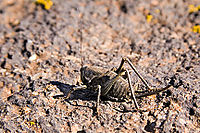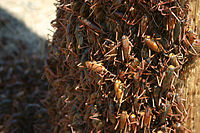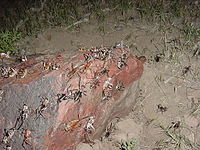- Mormon cricket
-
Mormon cricket 
Scientific classification Kingdom: Animalia Phylum: Arthropoda Class: Insecta Order: Orthoptera Family: Tettigoniidae Genus: Anabrus Species: A. simplex Binomial name Anabrus simplex
Haldeman, 1852The Mormon cricket (Anabrus simplex) is a large insect that can grow to almost three inches in length. They live throughout western North America in rangelands dominated by sagebrush and forbs.
Despite its name, the Mormon cricket is actually a shieldbacked katydid, not a cricket.
The Mormon cricket is flightless, but capable of traveling up to two kilometers a day[1] in its swarming phase, during which it is a serious agricultural pest and traffic hazard.
Contents
Appearance
Mormon crickets have variable coloration. The overall color may be black, brown, red, purple or green. The "shield" (pronotum or modified prothorax that covers vestigial wings) behind the head may have colored markings. The abdomen may appear to be striped. Females have a long ovipositor, which should not be mistaken for a stinger. Both sexes have long antennae.
Mormon crickets may undergo morphological changes triggered by high population densities, similar to those seen in locusts. The most noticeable change is in coloration: solitary individuals typically have green or purple coloration, while swarming individuals are often black, brown or red.
Life cycle
Mormon cricket eggs mostly hatch the spring after they are laid, although in some areas eggs may take as many as five years to hatch. Hatching begins when soil temperatures reach 40 °F (4 °C). The nymphs pass through seven instars before reaching the adult stage, typically taking 60 to 90 days.
Breeding begins within 10 to 14 days of reaching the adult stage. The male passes a large spermatophore to the female, which can be up to 27% of his body weight. The spermatophore is mostly food for the female to consume but also contains sperm to fertilize her eggs. The value of this nuptial gift is such that swarming-phase females compete for males. This sexual role-reversal is not seen in solitary-phase females.
The female lays her eggs by thrusting her ovipositor deep into the soil. Females can lay about one hundred eggs each.
Swarming
The Mormon cricket exists in populations of relatively low density throughout most of its range. However, at certain times and places, population explosions or infestations occur in which large numbers of the cricket form roving bands. These bands may include millions of individuals and be found with densities of up to 100 individuals per square meter. These infestations may last years or even decades, and are characterized by a gradual increase and then decrease in population. The factors that trigger these infestations are poorly understood, but are thought to be weather-related.
New research shows that Mormon crickets move in these migratory bands, firstly to find new sources of the critical nutrients of protein and salt, and secondly to avoid being eaten by hungry crickets approaching from the rear. The Mormon cricket's cannibalistic behavior may lead to swarm behavior because crickets may need to move constantly forward to avoid attacks from behind.[2]
When a large band crosses a road it can cause a safety hazard by causing distracted revulsion on the part of the driver, and by causing the road surface to become slick with Mormon cricket guts. The crickets also can cause devastation in agricultural areas.
Food
The Mormon cricket prefers to eat forbs, but grasses and shrubs such as sagebrush are also eaten, as are insects and other Mormon crickets (especially individuals that have been killed or injured by automobiles or insecticides). A recent study has suggested that the migration of swarms may be a strategy to avoid predation by other Mormon crickets.
During an infestation Mormon crickets can cause significant damage to crops and gardens.
Control
Mormon crickets are preyed upon by a wide variety of birds and mammals. These predators include California Gulls, crows, coyotes and various rodents. They were also eaten by Native Americans. There are no predators that specialize on Mormon crickets, which may be explained by the cricket's migratory habits and large population fluctuations.
The most common chemical control method used is carbaryl (typically sold as "Sevin") bait. This bait kills both the Mormon crickets that eat the bait, and the crickets that eat crickets that eat the bait. Insecticides applied directly to crops may kill the insects, but due to the large size of swarms this method usually does not save the crop from being destroyed.
As Mormon crickets are flightless, physical barriers may be effective. Barriers should be at least two feet high and made of a smooth material. Recently, residents of some small towns have been effectively using boom boxes and sound systems playing hard rock music to divert the moving swarms away from crops and houses. Music seems to deter the insects, although it is unknown if the result is due to the music or the heavy vibrations.[3]
Historical
Tradition tells of a story where the first Mormon settlement in Utah was saved from famine by gulls eating hordes of Mormon crickets that had been destroying their first wheat crop; hence the name of the insect. California Gulls are known to relocate to desert areas to feed on Mormon cricket swarms, although their effectiveness in controlling infestations is thought to be minimal. Tradition and recent eye-witness reports[citation needed] also mention that the gulls vomit after eating Mormon crickets, which may indicate they contain chemicals which induce aversion to eating more.
In 2003, officials in Utah, Idaho and Nevada said that year's infestation might be the worst in recent history.[4]
See also
References
- ^ http://drosophila.biology.kent.edu/users/plorch/LorchPdfs/Lorchetal2005.pdf
- ^ Sword, Prof Gregory. "Mormon Cricket Ecology and Evolution". http://www.bio.usyd.edu.au/molecular_ecology/research/crickets.shtml.
- ^ Jim Carlton (April 24, 2009). "Against Insect Plague, Nevadans Wield Ultimate Weapon: Hard Rock". Wall Street Journal. http://online.wsj.com/article/SB124052112850249691.html#mod=rss_whats_news_us.
- ^ James Nelson (June 14, 2003). "Mormon Crickets Devour Crops, Turn Roads 'Blood Red'". Reuters. http://www.cnn.com/2003/US/West/06/14/mormon.crickets.reut/.
External links
- "Anabrus simplex". Integrated Taxonomic Information System. http://www.itis.gov/servlet/SingleRpt/SingleRpt?search_topic=TSN&search_value=102264. Retrieved 9 February 2006.
- University of Florida description
- University of Wyoming description
- Cannibal crickets on a forced march for protein and salt
- From Ants to People, an Instinct to Swarm
Categories:
Wikimedia Foundation. 2010.




